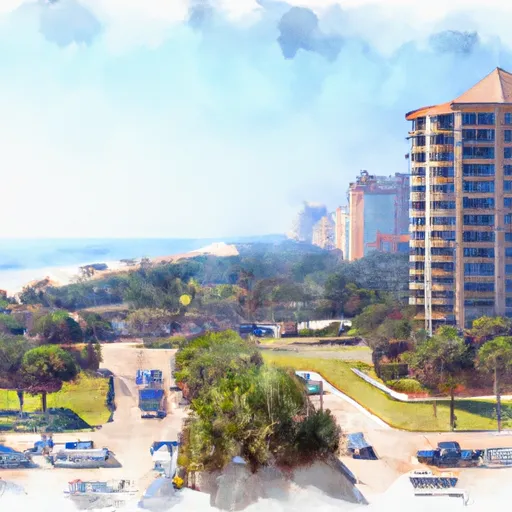-
 Snoflo Premium
Snoflo Premium
Get unlimited access to all our content
With no Ad interruptions! - Start Your Free Trial Login with existing account
Ponte-Vedra-Beac
Eden Index
Climate
7.5
•
Recreation
4.8
•
Community
6.0
•
Safeguard
6.2/10

Ponte Vedra Beach, Florida is a lovely coastal community located in St. Johns County. Known for its beautiful beaches and luxurious resorts, Ponte Vedra Beach experiences a humid subtropical climate. This means it boasts hot and humid summers with frequent afternoon thunderstorms, while its winters are mild and dry, making it an ideal year-round destination for outdoor activities.
The hydrology constituents of Ponte Vedra Beach include the Atlantic Ocean, the Intracoastal Waterway, and various lagoons and marshes. These water bodies provide residents and visitors with opportunities for boating, fishing, kayaking, and other water sports. The area is also home to the Guana Tolomato Matanzas National Estuarine Research Reserve, a protected marshland that offers educational programs and hiking trails.
In addition to its water-based activities, Ponte Vedra Beach is renowned for its championship golf courses, including TPC Sawgrass, which hosts The Players Championship. The community is also surrounded by nature preserves and state parks, offering opportunities for hiking, biking, and wildlife spotting.
Overall, Ponte Vedra Beach provides a diverse range of outdoor recreation opportunities for nature enthusiasts and water sports lovers, all within a stunning coastal setting.
What is the Eden Index?
The Snoflo Eden Index serves as a comprehensive rating system for regions, evaluating their desirability through a holistic assessment of climate health, outdoor recreation opportunities, and natural disaster risk, acknowledging the profound impact of these factors on livability and well-being.
Climate Health Indicator (CHI): 7.5
Ponte-Vedra-Beac receives approximately
1287mm of rain per year,
with humidity levels near 88%
and air temperatures averaging around
21°C.
Ponte-Vedra-Beac has a plant hardyness factor of
9, meaning
plants and agriculture in this region tend to thrive here all year round.
By considering the ideal temperature range, reliable water supplies, clean air, and stable seasonal rain or snowpacks, the Climate Health Indicator (CHI) underscores the significance of a healthy climate as the foundation for quality living.
A healthy climate is paramount for ensuring a high quality of life and livability in a region, fostering both physical well-being and environmental harmony. This can be characterized by ideal temperatures, reliable access to water supplies, clean air, and consistent seasonal rain or snowpacks.
Weather Forecast
Streamflow Conditions
East Florida Coastal
Area Rivers
East Florida Coastal
Snowpack Depths
East Florida Coastal
Reservoir Storage Capacity
East Florida Coastal
Groundwater Levels
Recreational Opportunity Index (ROI): 4.8
The Recreational Opportunity Index (ROI) recognizes the value of outdoor recreational options, such as parks, hiking trails, camping sites, and fishing spots, while acknowledging that climate plays a pivotal role in ensuring the comfort and consistency of these experiences.
Access to outdoor recreational opportunities, encompassing activities such as parks, hiking, camping, and fishing, is crucial for overall well-being, and the climate plays a pivotal role in enabling and enhancing these experiences, ensuring that individuals can engage in nature-based activities comfortably and consistently.
Camping Areas
| Campground | Campsites | Reservations | Toilets | Showers | Elevation |
|---|---|---|---|---|---|
| Princess Place Preserve | None | 5 ft | |||
| Alexander Springs | 181 | 49 ft | |||
| Hontoon Island State Park | None | 0 ft | |||
| Lake Monroe | None | 14 ft | |||
| Blue Spring State Park | None | 69 ft | |||
| Faver - Dykes State Park | None | 9 ft | |||
| Kelly | None | 71 ft | |||
| Anastasia State Park | 139 | 10 ft | |||
| Clearwater Lake | 62 | 81 ft | |||
| Hanna City Park | 300 | 17 ft |
Catastrophe Safeguard Index (CSI):
The Catastrophe Safeguard Index (CSI) recognizes that natural disaster risk, encompassing floods, fires, hurricanes, and tornadoes, can drastically affect safety and the overall appeal of an area.
The level of natural disaster risk in a region significantly affects safety and the overall livability, with climate change amplifying these risks by potentially increasing the frequency and intensity of events like floods, fires, hurricanes, and tornadoes, thereby posing substantial challenges to community resilience and well-being.
Community Resilience Indicator (CRI): 6.0
The Community Resilience Indicator (CRI) recognizes that education, healthcare, and socioeconomics are crucial to the well-being of a region. The CRI acknowledges the profound impact of these elements on residents' overall quality of life. By evaluating educational resources, healthcare accessibility, and economic inclusivity, the index captures the essential aspects that contribute to a thriving community, fostering resident satisfaction, equity, and social cohesion.

